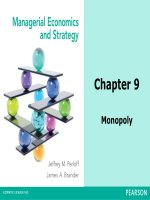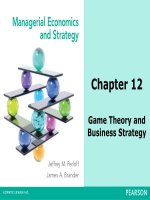Managerial economics strategy by m perloff and brander chapter 13strategies over time
Bạn đang xem bản rút gọn của tài liệu. Xem và tải ngay bản đầy đủ của tài liệu tại đây (389.36 KB, 35 trang )
Chapter 13
Strategies Over
Time
Table of Contents
• 13.1 Repeated Games
• 13.2 Sequential Games
• 13.3 Deterring Entry
• 13.4 Cost Strategies
• 13.5 Disadvantages of Moving First
• 13.6 Behavioral Game Theory
13-2
© 2014 Pearson Education, Inc. All rights reserved.
Introduction
• Managerial Problem
– Intel and AMD dominate the central processing unit (CPU) market for
personal computers, making 95% of total sales.
– Why have Intel’s managers chosen to advertise aggressively while AMD
engages in relatively little advertising?
• Solution Approach
– We need to explore dynamic games where players play the game over and
over, and move either repeatedly or sequentially.
• Empirical Methods
– Dynamic games could be repeated games or sequential games.
– Under some conditions firms may benefit from pursuing deterring entry
and cost strategies, or may find disadvantages of moving first.
– Behavioral game theory shows how managers may act based on simple
rules or psychological factors rather than rational strategies.
13-3
© 2014 Pearson Education, Inc. All rights reserved.
13.1 Repeated Games
• Repeated Games and Rules
– The static constituent game might be repeated a finite and pre-specified
number of times, or repeated indefinitely.
– In a repeated game, managers need to know the players, the rules, the
information that each firm has, and the payoffs or profits.
– A manager must also distinguish between an action and a strategy.
• Strategies & Actions in Repeated Games
– An action is a single move that a player makes at a specified time, such as
choosing an output level or a price.
– A strategy is a battle plan that specifies the full set of actions that a player
will make throughout the game. It may involve actions that are conditional
on prior actions of other players or on new information available at a given
time.
13-4
© 2014 Pearson Education, Inc. All rights reserved.
13.1 Repeated Games
• Cooperation in a Repeated Prisoner’s Dilemma Game
– Table 13.1 repeats the American-United game of Chapter 12. The Nash
equilibrium solution, if played only once, is both firms producing high (64
passengers) and making only $4.1 (Prisoner’s Dilemma game).
– Assume the same game is repeated indefinitely. Now, firms must consider
current and future profits, and must distinguish an action from a strategy.
• Strategies to Avoid a Prisoner’s Dilemma Outcome
– Firms can follow a trigger strategy, in which a rival’s defection from a
collusive outcome triggers a punishment.
– If United uses this strategy, its action in the current period depends on
American’s observed actions in previous periods. Similarly for American.
13-5
© 2014 Pearson Education, Inc. All rights reserved.
13.1 Repeated Games
• A Trigger Strategy for Airline Repeated Game
– American cheap-talks United that it will produce the 48 collusive or
cooperative quantity in the 1st period, but then its action will depend: if
United produces 48 in period t, American will produce 48 in t + 1; if United
produces 64 in period t, American will produce 64 in t + 1 and all
subsequent periods.
• Nash-Equilibrium with no Prisoner’s Dilemma
– United’s best response strategy is to produce 48 in each period: the
incremental profit from producing 64 one time does not compensate all
future losses.
– If both firms follow the trigger strategy, the Nash-Equilibrium is the best
outcome.
– In reality, cooperation may fail because of regulation, bounded rationality,
or if a firm cares little about future profits.
13-6
© 2014 Pearson Education, Inc. All rights reserved.
13.1 Repeated Games
Table 13.1 An Airlines Prisoners’ Dilemma
Game with Two Actions
13-7
© 2014 Pearson Education, Inc. All rights reserved.
13.1 Repeated Game
• Another Possible Trigger Strategy: Tit-for-Tat
– A tit-for-tat strategy for repeated prisoners’ dilemma games sets
cooperation in the 1st round, then copies the rival’s previous action in each
subsequent round.
– A tit-for-tat strategy is a punishment strategy weaker than the previous
trigger strategy.
• Tit-for-Tat May Not Induce Cooperation
– Tit-for-Tat may not induce cooperation in the Airline repeated game if the
extra profit in period t is greater than the loss from the punishment in
period t + 1.
– However, if the tit-for-tat strategy is modified to extend the punishment
for more than one period (enough to more than compensate the one time
extra profit), then it may ensure cooperation.
13-8
© 2014 Pearson Education, Inc. All rights reserved.
13.1 Repeated Game
• Implicit Versus Explicit Collusion
– In most modern economies, explicit collusion among firms in an industry is
illegal.
– However, antitrust laws do not strictly prohibit choosing the cooperative
(cartel) quantity or price as long as no explicit agreement is reached.
• Implicit Collusion
– Firms may be able to engage in such implicit collusion or tacit collusion
using trigger, tit-for-tat, or other similar strategies, as long as firms do not
explicitly communicate each other.
– Tacit collusion lowers society’s total surplus just as explicit collusion does.
13-9
© 2014 Pearson Education, Inc. All rights reserved.
13.1 Repeated Games
• Finitely Repeated Games
–
–
American and United know that the game in Table 13.1 will be repeated only a finite
number of times, T. They cheap-talk the trigger strategy mentioned before.
Both firms know there is no punishment in the final period T. So it is basically a
static Prisoner’s Dilemma and both firms have a dominant strategy: produce 64.
• Going Backwards from the Last to the 1st Period
–
–
–
–
Period T: Each firm ‘cheats’ and produces 64 for certain.
Period T - 1: Nothing that each firm does will avoid the punishment in period T. So, it
is better to ‘cheat’, produce 64 and earn extra profit.
Period T - 2: Each firm cheats because they know both will cheat in T – 1 anyway.
Period T - 3 up to the 1st period: Same logic
• No Cooperation Again!
–
–
13-10
The only Nash equilibrium is 64 & 64 to occur in every period.
Thus, maintaining an agreement to cooperate in any prisoners’ dilemma game is
more difficult if there is a known end point and players have complete foresight.
© 2014 Pearson Education, Inc. All rights reserved.
13.2 Sequential Games
• Stages & Extensive Form
– Sequential game: many stages or decision points and players alternate
moves
– Extensive form: a branched diagram that shows the players, the sequence
of moves, the actions players can take at each move, the information that
each player has about previous moves, and the payoff function over all
possible strategy combinations
• Subgame Perfect Nash-Equilibrium
– At any given stage, players play a subgame (actions and corresponding
payoffs).
– Subgame perfect Nash equilibrium: if the players’ strategies form a Nash
equilibrium in every subgame (including the overall game)
• Backward Induction for Subgame Perfect Nash-Equilibrium
– First determine the best response by the last player to move, then
determine the best response for the player who made the next-to-last
move, and so on until we reach the first move of the game.
13-11
© 2014 Pearson Education, Inc. All rights reserved.
13.2 Sequential Games
• Stackelberg Oligopoly Game
– Two-stage, sequential-move oligopoly game: American, the leader firm,
chooses its output level first. Given American’s choice, United, the
follower, picks an output level.
– All information is shown in extensive form, Figure 13.1.
• Backward Induction and Subgames
– American determines what United, the follower, will do in the 2 nd stage at
the tree subgames (right in Figure 13.1): qU with highest profit at each
node.
– American determines its best action in the 1st stage given the choices of
United in the 2nd stage (left in Figure 13.1): qA with the highest profit.
• Subgame Perfect Nash-Equilibrium
– Thus, American chooses qA = 96 in the 1st stage and United chooses qU =
48 in the 2nd stage. In this equilibrium, neither firm wants to change its
strategy.
13-12
© 2014 Pearson Education, Inc. All rights reserved.
13.2 Sequential Games
Figure 13.1 Airlines’ Stackelberg Game Tree
13-13
© 2014 Pearson Education, Inc. All rights reserved.
13.2 Sequential Games
• Credible Threats
– The Nash equilibrium of the American-United static simultaneous game
(Cournot with 3 options) was qA = qU = 96 and both firms earned $4.1
million (Chapter 12).
– The Subgame Perfect Nash Equilibrium of the American-United sequential
game (Stackelberg) is qA = 96 , qU = 48. American earns $4.6 million, but
United only $2.3 million.
– Why different solutions?
• Credible Threat and First Mover Advantage
– For a firm’s announced strategy to be a credible threat, rivals must believe
that the firm’s strategy is rational (works in the firm’s best interest).
– In the simultaneous-move game, United will not believe a threat by
American that it will produce 96. However, in the sequential game
because American makes the 1st move, its commitment to produce 96 is
credible.
13-14
© 2014 Pearson Education, Inc. All rights reserved.
13.3 Deterring Entry
• Exclusion Contracts
– A mall has a single shoe store, the incumbent firm. The incumbent may
pay the mall’s owner b to add a clause to its rental agreement that
guarantees exclusivity. If b is paid, the landlord agrees to rent the
remaining space only to a no-shoe firm.
– The game tree, Figure 13.2, shows the two stages of the game. In the 1st
stage, the incumbent decides whether to pay b to prevent entry. In the 2nd
stage, the potential rival decides whether to enter. If it enters, it incurs a
fixed fee of F to build its store in the mall.
• Backward Induction for Subgame Perfect Nash-Equilibrium
– Last decision made by potential rival in 2nd stage: to the right in Figure
13.2, the rival only plays one subgame. It enters if F ≤ 4 because πr = 4 –
F. Otherwise, stays out with πr = 0.
– Decision made by incumbent in 1st stage knowing what potential rival will
do in 2nd stage: to the left in Figure 13.2, the incumbent has one subgame,
but the decision to pay depends on the values of the exclusivity fee b and
fixed cost F.
13-15
© 2014 Pearson Education, Inc. All rights reserved.
13.3 Deterring Entry
• Three Possible Outcomes that Depend on b and F
– Blockaded entry (F > 4): Potential rival will stay out ensuring πr = 0. So,
the incumbent avoids paying b and still earns the monopoly profit, πi = 10.
– Deterred entry (F ≤ 4, b ≤ 6): Potential rival will enter unless the
incumbent pays the exclusivity fee. The incumbent chooses to pay b
because b ≤ 6 ensures a profit at least as large as the duopoly profit of 4
(πi = 10 – b ≥ 4).
– Accommodated entry (F ≤ 4, b > 6): Potential rival will enter to earn a
positive profit of πr = 4 – F. The incumbent does not pay the exclusivity fee
because b is so high that it is better to ensure πi = 4 than earn less (πi =
10 – b < 4).
•
When to Pay the Exclusivity Fee?
– In short, the incumbent does not pay for an exclusive contract if the
potential rival’s cost of entry is prohibitively high (F > 4) or if the cost of
the exclusive contract is too high (b > 6).
13-16
© 2014 Pearson Education, Inc. All rights reserved.
13.3 Deterring Entry
Figure 13.2 Paying to Prevent Entry
13-17
© 2014 Pearson Education, Inc. All rights reserved.
13.3 Deterring Entry
• Limit Pricing
– A firm is limit pricing if it sets its price (or, equivalently, its output) so that
another firm cannot enter the market profitably.
– To successfully limit price, a firm must have an advantage over its rivals.
• Limit Pricing Example
– An incumbent firm is making a large monopoly profit, which attracts the
interest of a potential rival. The incumbent could announce that, after
entry, it will charge a price so low that the other firm will make a loss.
– This threat is credible only if the incumbent has a cost advantage over its
rival.
• Stackelberg Example
– The Stackelberg leader acts first and produces a large quantity so that the
follower produces a smaller quantity with no profit.
– The leader makes limit pricing credible by committing to provide a very
large output level.
13-18
© 2014 Pearson Education, Inc. All rights reserved.
13.3 Deterring Entry
• Entry Deterrence in a Repeated Game
– A grocery chain with a monopoly in many small towns faces potential entry
by other firms in some or all of these towns.
– Figure 13.3 shows the game in only one town. In the 1 st stage, the rival
decides to enter the town or not. In the 2 nd stage, the incumbent decides
between fighting with the rival (price war) or accommodating the rival.
• Accommodation if Game Played only Once
– If this game is played only once and if the profits are common knowledge,
then the only subgame perfect Nash equilibrium is for entry to occur and
for the incumbent to accommodate entry.
• Price War if Repeated and Incomplete Information
– If the chain’s profits are not common knowledge and the game will be
played in many towns, the incumbent may want to fight back to build
reputation.
– Fighting the first rival is part of a rational long-run strategy and can be part
of a subgame perfect Nash equilibrium in which entry is successfully
deterred.
13-19
© 2014 Pearson Education, Inc. All rights reserved.
13.3 Deterring Entry
Figure 13.3 A Constituent Game of a
Repeated Entry Game
13-20
© 2014 Pearson Education, Inc. All rights reserved.
13.4 Cost Strategies
• Moving First
– A firm may be able to gain a cost advantage over a rival by moving first.
– We start by examining two cases.
• Moving First and Own Marginal Cost
– A firm moves first to gain a marginal cost advantage over its rivals.
– It can lower its own marginal cost by using a capital investment or
increasing the rate of learning by doing.
• Moving First and Rival’s Marginal Cost
– A firm moves first to increase the rivals’ marginal cost by more than its
own.
13-21
© 2014 Pearson Education, Inc. All rights reserved.
13.4 Cost Strategies
• Investing to Lower Marginal Cost
– A monopoly considers installing robots on its assembly line that would
lower its MC. Under normal conditions, this investment does not pay
(investment cost > extra profit). But, a rival threatens to enter the market.
– In Figure 13.4’s game tree, the incumbent decides whether to invest in the
first stage and the potential rival decides whether to enter in the second
stage.
• Backward Induction
– First, rival decides entry decision in 2nd stage: rival plays two subgames and
decides the best action for each subgame based on highest profit values πr.
– Second, incumbent decides investment decision in 1st stage after rival
decided in 2nd stage: incumbent plays one subgame and decides to invest
(πi = 8 > πi = 4).
• Subgame Perfect Nash Equilibrium
– The incumbent makes the ‘unprofitable’ investment to deter the entry of
potential rivals and earns πi = 8.
13-22
© 2014 Pearson Education, Inc. All rights reserved.
13.4 Cost Strategies
Figure 13.4 Investing to Prevent Entry
13-23
© 2014 Pearson Education, Inc. All rights reserved.
13.4 Cost Strategies
• Learning by Doing
– Learning by Doing: the more cumulative output a firm has produced, the
lower its marginal cost, as its workers and managers learn by doing.
– In the presence of learning by doing, the first firm in a market may want to
produce more than the quantity that maximizes its short-run profit, so that
its marginal cost is lower than that of a late-entering rival.
• Two Real Examples: Aircraft and Computer Chips
– An aircraft manufacturer may price below current marginal cost in the
short run, because of its steep learning curve. The price of the Lockheed L1011 was below the static MC for its entire 14-year production run
(Benkard, 2004).
– AMD’s cost of computer chips was about 12% higher than Intel’s cost.
AMD had less learning by doing because it had produced fewer units
(Salgado,2008).
13-24
© 2014 Pearson Education, Inc. All rights reserved.
13.4 Cost Strategies
• Raising Rival’s Costs
– A firm may benefit from using a strategy that raises its own cost but raises
its rivals’ costs by more.
– Such strategies usually favor the first mover or incumbent against the
rivals.
• Strategies for Incumbents to Raise Rival’s Costs
– Lobby the government for more industry regulations that raise costs, as
long as the legislation grandfathers existing firms’ plants (exemption).
– Increase the cost of switching by imposing a switching fee to customers
that take their business elsewhere or designing products that don’t work
with the rival’s.
– Use patents to prevent rivals entering the market and increasing
competition.
13-25
© 2014 Pearson Education, Inc. All rights reserved.









